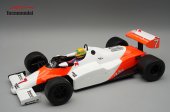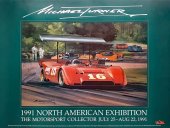COVER STORY
Formula 1 World Championship 1983
Nelson Piquet's path to the first turbo world championship in Formula 1
Ulrich Baretzky on his work at BMW Motorsport
Interview René Arnoux
High-pressure power from Maranello – Ferrari 126 C2 and 126 C3
Interview Eddie Cheever
Statistics – F1 teams and drivers 1983
- Eckhard Schimpf about Michael Bartels
- Robert Weber on the “Wirthaus M1” in Le Mans
- David Brabham and the XJR-14 at the Goodwood Festival of Speed
- John Nikas on the Pebble Beach Concours d'Elegance 2023
- Oliver Mathai on the Jochen Rindt Trophy at Thruxton
- Jochen Weiss on his participation in the 2023 Oldtimer Grand Prix
40 years ago, for the first time in Formula 1 history, a driver with a turbo engine triumphed in the premier class of the automobile world championship: Nelson Piquet in his Brabham-BMW BT52, which connoisseurs like to call the most beautiful monoposto of all time. Piquet's unwavering commitment and unconditional belief in the German four-cylinder turbo engine were ultimately rewarded with the title. AUTOMOBILSPORT is taking the anniversary year as an opportunity to retrace the path of the first turbo world champion. The texts are taken from the book entitled "In 630 days to the top - the world championship story of the BMW Turbo". It was written by our columnist Uwe Mahla, who, as a contemporary witness and BMW press spokesman, accompanied the adventurous journey from Brazil via North America and Europe to South Africa. The booklet has long been out of print, but Mahla has extracted the most exciting stops and coincidences from his early work for us in the form of the original texts from back then. So let's accompany Nelson Piquet on his journey to the title - his second and first as turbo world champion in Formula 1.
A brief outline of how it came about to give you a better understanding. The starting point was the four-cylinder in-line engine, which was very advanced for its time and originally came from comparatively close-to-production saloons, such as the BMW 1800 Ti. This engine won sporting laurels early on. Performance was increased over the years by means of twin carburettors, fuel injection and soon also as a supercharged and four-valve version.
At the same time, BMW engineers developed the tried-and-tested engine for Formula 2, the competitiveness of which is evidenced not least by six European Championship titles. It was not long before the four-valve technology and turbocharging were harmonised and made to work under the direction of Paul Rosche.
To cut a long story short, at some point the dyno displayed values that suggested that this would be an engine for Formula 1, because at that time naturally aspirated engines were used in this championship according to three-litre regulations; however, turbo engines with a displacement of 1.5 litres were also permitted.
Let's skip the political turmoil and realise that BMW entered Formula 1 in 1982 with Brabham owner Bernie Ecclestone. This first year was not exactly a walk in the park, as it was necessary to make up for Renault's five years of experience and Ferrari's three years. Nevertheless, Piquet's first victory in Montreal on 13 June 1982 in only his fifth race made even the sceptics realise what potential lay dormant here.
In retrospect, the record of the four-cylinder BMW engine in Formula 1 reads like this in bare figures: 91 Grand Prix starts (South Africa 1982 to Australia 1987), first world championship points for Piquet's fifth place in the fifth race in Belgium, first pole position at the 1982 Austrian GP, 15 pole positions with maximum power of up to 1400 hp, nine victories (seven times Piquet, once each Patrese and Berger), 13 fastest laps ( Piquet 9, Patrese 2, Berger 2), used by the ATS, Brabham, Arrows and Benetton teams…
In the middle of the 1980 season, the decision was made in Maranello to design a completely new Formula 1 racing car to replace the now obsolete Ferrari 312 T. The result was the Ferrari 126. The result was the Ferrari 126, the first turbocharged Formula 1 Ferrari since the 125 F1, which had been launched three decades earlier. With the various development stages of the car, the Scuderia won the constructors' championship twice in succession in 1982 and 1983. Although the drivers' titles went to the competition - due to technical defects, Villeneuve's fatal accident and Pironi's broken leg - the Type 126 was nevertheless the most successful Ferrari of the turbo era.
In 1979, Jody Scheckter won the Formula 1 World Championship with the Ferrari 312 T4. Second place went to his team-mate Gilles Villeneuve, who had put his own interests behind those of the Italian brand. The winning car was powered by the legendary three-litre 180-degree flat-six engine, a masterpiece by Mauro Forghieri. In its final configuration in the 312 T5, the naturally aspirated engine produced around 515 hp, but this was not enough to compete against the powerful turbo engines from Renault and the teams with the outdated Ford Cosworth DFV in 1980. The 1980 season turned out to be a disaster for Ferrari. After the six victories in 1979 - three each for Scheckter and Villeneuve - Ferrari finished tenth in the 1980 constructors' championship with a meagre total of eight points and remained winless. There was therefore an urgent need for action to make the team from Maranello competitive again.
The first Ferrari of the turbo era
Ferrari was already considering a 1.5-litre turbo engine in 1977 when it realised that Renault was on the right track with its turbo development (although the French did not achieve the first turbo victory until the French Grand Prix in the summer of 1979). However, as the various versions of the 312 T had proved to be extremely capable of winning, Ferrari waited to develop a turbo engine. When the 312 T5 was lagging behind the competition in 1980 due to its inferior chassis rather than a weakness in the engine, the engineers in Maranello were busy designing and developing the new 1.5-litre turbo engine at the same time.
This special BMW M1 started with the original line-up at this year's Le Mans Classic, 42 years after its entry in the 1981 24 Hours of Le Mans. BMW Classic celebrated 100 years of Le Mans, 50 years of BMW France and the 80th birthday of His Royal Highness Prince Leopold of Bavaria with this special entry.
The main protagonists look back with a smile at the time. "I can well remember how we met in front of the Spatenhaus when the car was presented to the press for the first time," says Prince Leopold von Bayern. "We were in short lederhosen, each holding a pint of beer."
Imagine the public debate that would break out today if publicans sponsored a racing car and the racing drivers posed with full beer mugs at the presentation. In times of "gendering", free choice of gender and supposed "political correctness", it is a small ray of hope that people were at least once thought to have enough sense of responsibility to be able to distinguish between a pint of beer next to a stationary car and drunk driving.
Because in 1981, BMW and the initiators naturally focussed on sporting success. Walter Maurer remembers how the project came about: "BMW racing director Dieter Stappert came to me at the time and presented me with the plans. The idea was probably born at the Emmeramsmühle. Together with Dirk Henning Strassl, the BMW press spokesman at the time, Mr Heckle, a Munich building contractor, and the landlord of the Emmeramsmühle, they wanted to enter a purely Munich car in Le Mans."
The BMW M1 was initially not homologated due to a lack of production numbers and, with a few exceptions, was only used in the Procar series. This changed on 1 April 1981, when the homologation number was finally reached and the M1 was allowed to compete in Group 4…
On his mobile phone, his voice sounds like it used to. Straightforward, clear, slightly tense. Michael Bartels is sitting in the car. What is he up to? "I'm driving towards Switzerland right now. I was at the Le Mans Classic. Now it's Estoril." Life on the road. Just like back then, 30 years ago. The now 55-year-old was karting champion (1985), Formula Ford champion (1986), followed by Formula 3, Formula 3000 and DTM. Only the leap into Formula 1 failed. But in the final years of his career (at the end of 2012), he became a multiple GT champion and was once again GT world champion in the Maserati MC12 in 2010. He is still involved with the cars of this legendary brand to this day.
I knew Michael when he was five years old and used to climb around in our Porsches. Back then, when his father Willi Bartels and I used to duel in the Jägermeister Carreras in various hill climbs. When we sat at dinner in the evening, in some vine-covered locanda in Italy or in a bistro in France, his father would make plans for his son's future. "My Michi," he said, "he's a great kid. I'll turn him into a Formula 1 driver one day." Father Bartels gave it a try. The 1971 and 1976 European mountain champion invested a lot of money, which was not always easy to earn with his DIY stores, in Michael's career. It was well worth it, because Michael Bartels (born in 1968 in Plettenberg, Sauerland) developed into an internationally respected thoroughbred racer.
There are photos of him standing next to Michael Schumacher and Heinz-Harald Frentzen on the winners' podium. In the Formula 3 races of the 1980s, Michael Bartels still hoped to gain a foothold in Formula 1. His two rivals from his youth made it - one as the absolute superstar, the other as a long-time top driver and Grand Prix winner. Michael Bartels remained a league below. However, there is no denying that he can still be considered an experienced top driver. He won the 24 Hours of Nürburgring twice (2000 and 2001), the 24 Hours of Spa three times (2005, 2006, 2008) and the Touring Car Grand Prix in Macau once (1999).
In 1991, Bartels tried four times to qualify for a Formula 1 Grand Prix in a Lotus-Judd. He failed four times (at the German, Hungarian, Italian and Spanish Grand Prix). But in this context, it makes sense to take a closer look. Lotus was no longer a top team and Bartels' team-mate was Mika Häkkinen, who later became world champion (1998 and 1999). This 1991 season still belonged to the era when up to 38 cars tried to qualify for one of the 26 grid positions at each round of the world championship. At Hockenheim 1991, Häkkinen managed to "devil" his way onto the grid in 23rd place with a time of 1:42.7 minutes. Michael Bartels clocked 1:43.6 and failed to qualify in 28th place, just nine tenths of a second behind Mika Häkkinen! Isn't that also significant? Today, nine tenths of a second is a lot, back then it was nothing…
This product was added to our catalog on Friday 23 February, 2024.




